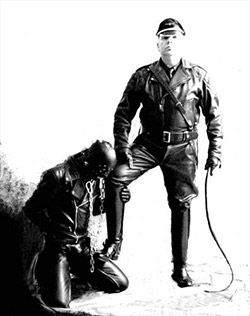I self-identify as a kinkster and, like many others, I have spent a long time reflecting on and questioning my own characteristics and personality, and the desire and longing for a life that (for me) is geographically nearly impossible to achieve. I live in Malaysia, where you don’t see anyone wearing collars or use any secret hanky code, let alone look like the punks, skinheads, bikers, or other subcultures I see in my Tumblr feed.
Waking up everyday, I battle and juggle between a fictional ideal head-space and physical practical interaction with the society I live in.
Yet, we still continue to identify ourselves as “kinkster” in many ways and attempt to differentiate ourselves from “the other”, and when we are interacting with fellow kinksters online, through social media or forums, we again try to differentiate ourselves from “the-other-kinkster” through categorising our interests or values or “the kind of kinkster we are”.
That process of discovering our position within our own interpersonal kink and non-kink circles can be very confusing. Some of us yearn for the intellectual good old days of the invisible Old Guard BDSM community. We read that Old Guard literature — books by esteemed authors, theories of Leather brotherhood, maybe even an SM table of Masters and slaves.
In navigating our circles, we might question – where is the Old Guard? — being frustrated that we aren’t part of a better, less sexually focused, BDSM community that talks about rituals, protocols and matters of theory. We start to point our fingers at easy targets such as this generation, our generation, the new generation. Perhaps something mysterious [insert your opinion of why the Old Guard is missing] has happened that took away our good old traditions and the Old Guard BDSM community that guarded them.
Nothing changes, yet everything changes. Why is that?
I’ll be up-front. I’m not a cultural researcher who has immersed himself in five years of research mapping the flow of BDSM culture in different places. This is my humble observation from my own angle. Feel free to debate and challenge my idea.
BENEDICT ANDERSON’S IMAGINED COMMUNITY
Bennedict Anderson (1992) suggests recognizing the fact that the existence of a community is through imagination and fictional conceptualization. His concept of Imagined Community is focused on National Identity, but I think it is highly relevant to use that concept to explain the BDSM community as a subculture, and some of the questions we have.
The emotions that yearn for the better BDSM community (the Old Guard ways), in many ways is similar to a citizen who feels nostalgic about the good old national culture — the good old “Britain” or “US” or “Malaysia”. Many things have changed in the past few decades, as new media technology has evolved, and we quite often look at cultural changes from the viewpoint of pre-internet versus post-internet.
The concept of Imagined Community isn’t some sort of inexplicably unfathomable dragon. It asks a simple question. How do we know the BDSM community exists, without meeting everyone from the world to verify our belief of what the BDSM community is and/or is not?
He suggests that (a) community that is imagined, is inherently limited and sovereign. Our imagination of the BDSM community draws from our own perceptions of what the community is like.
DID WE IMAGINE THE OLD GUARD?
Still, where is the Old Guard? Why can’t we be part of the Old Guard?
Since the internet explosion, mass media and computer mediated communicative technology has transform our interaction with the world. It has impacted human understanding of our worldview in many different ways. One of the impacts is how we imagine our community, because we now absorb information from all over the internet. It has now becoming less limited, faster in velocity, and sometimes that interferes with our belief of “tradition” and “the old days”, because we now see a lot more things than we saw in the past.
For example, in the old days, to get to know BDSM culture, we could only read from a magazine or book, or go to a bar, and that is how we imagine the Old Guard. Today, we have Recon, Fetlife and fifty shades of multiple video feeds. Everyone is communicating their own perspective of what BDSM means to them, and they’re visible in the cyberspace. Our perception of BDSM culture has shifted from a rather limited, constrained, boundary of what an “imagined BDSM community” is like, to come face to face and interact with what “people are actually doing”. So, our imagined Old Guard BDSM often doesn’t look like all that “actual” information we are getting.
PERHAPS IT’S OUR IMAGINATION THAT HAS CHANGED
Appadurai (1996) called the change of imagination “community of sentiment”. This greater individual capability to achieve and explore intimacy among different identities has turn into staging ground for identity performance, that spreads over a big and irregular space and links one to another through sophisticated media capabilities.
 But all of this connectivity, all these Fetlife/Grindr/Recon/Forum profiles and microblogging journals of Master and slave, still relies heavily on user’s imagination.
But all of this connectivity, all these Fetlife/Grindr/Recon/Forum profiles and microblogging journals of Master and slave, still relies heavily on user’s imagination.
In Appadurai’s language… such individual’s imagination exists and is fostered in a manner which “palimpsest of highly local and highly translocal considerations”. The imagination of the individual has becomes an active agent, and feeds in to the imagined community. To revisit our metaphorical imagination of the table of BDSM community from the recent artcle “Where Did Old School BDSM Go?” to better explain the concept:
Here’s a quick metaphor that might be helpful. There are people who feel like their thing (meaning: their traditions, the way they were taught, the way they think things should be done) is “the table”, and newcomers get to take a seat and learn. This can be especially true for people we term Old Guard, who tend to be deeply rooted in traditions.
But, actually, the whole community is “the table”. Everyone has a right to a seat. It doesn’t matter who you are, you’re really just someone sitting at “the table”, you’re not the furniture itself.
The imaginary table of BDSM community hasn’t changed. The way we imagine who is sitting at the table has changed. An imagery of an “Old Guard lost in the 21st century” changes our belief of what BDSM community is, and impacts our behaviours, actions, and performance of who we are in differentiating ourselves as “Vanilla and Non-vanilla”, then later into “Old Guard and New Guard”, “Intellectual and Non-intellectual”.
Old Guard BDSM hasn’t disappeared or appeared, there are kinksters who take BDSM very seriously and there are those who are very casual about it.
Us wondering where the Old Guard had gone actually has very little to do with the existence of the Old Guard. It is really about our imagined world, and how it is, perhaps, becoming less magical or believable.
Anderson, B. (1992), Imagined Communities, New York: Verso.
Appadurai, A. (1996), Modernity At Large: Cultural Dimensions of Globalization, Minneapolis MN: University of Minnesota Press.
